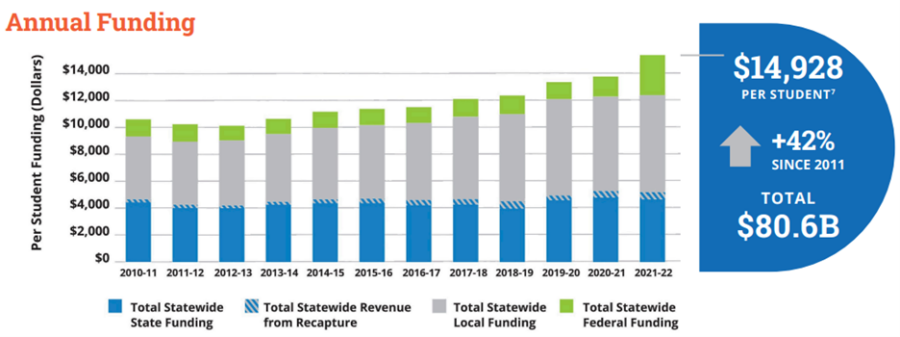As school districts across Texas begin to consider their 2024-25 budgets, which will likely be adopted in the late summer and early fall, many top-ranking officials are complaining about the difficult fiscal environment, suggesting they don’t have enough to make it through.
In Bryan ISD, for example, one official warned about the district’s dire circumstances, saying: “There’s absolutely a budget crisis in this state. Fortunately, in Bryan ISD, we’re not having to close campuses, but in many school districts across the state, that is the situation they are in.”
This comment and others like it got us wondering—is there any truth to the claim?
To begin making that determination, we surveyed the Texas Education Agency’s 2023 Annual Report for any information on school funding. It turns out that school budgets have a lot of padding.
According to the agency’s report, school districts collectively received $80.6 billion in the 2021-22 school year, which is an increase of 42% since 2011. On a per pupil basis, school districts received an average of almost $15,000 per student. That’s a chiefly sum to spend every year on public education, especially considering the return on investment.

But perhaps the fiscal situation is different in Bryan ISD. To get a sense of the answer, we used the education agency’s PEIMS District Financial Actual Reports to determine that Bryan ISD’s total operating and other revenue for the 2022-23 school year was $241.6 million, or about $15,092 per pupil. In other words, it was slightly higher than the statewide average.
It is difficult to look at the state of play today in public school finance—wherein Texas taxpayers are contributing $15,000 per child—and agree that we have a funding crisis. If anything, we have a spending problem that is quickly getting out of hand.
As has been extensively documented, school districts across have squandered public monies on water park, private planes, and lavish taxpayer-funded homes. Worse, school districts with declining attendance continue to go on spending sprees while others pay school superintendents outrageous salaries. Meanwhile, ISD debt rages out of control.
And even after all of that, Texas public schools still say they need more. Which raises a pressing and important question: How much will ever be enough?